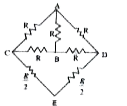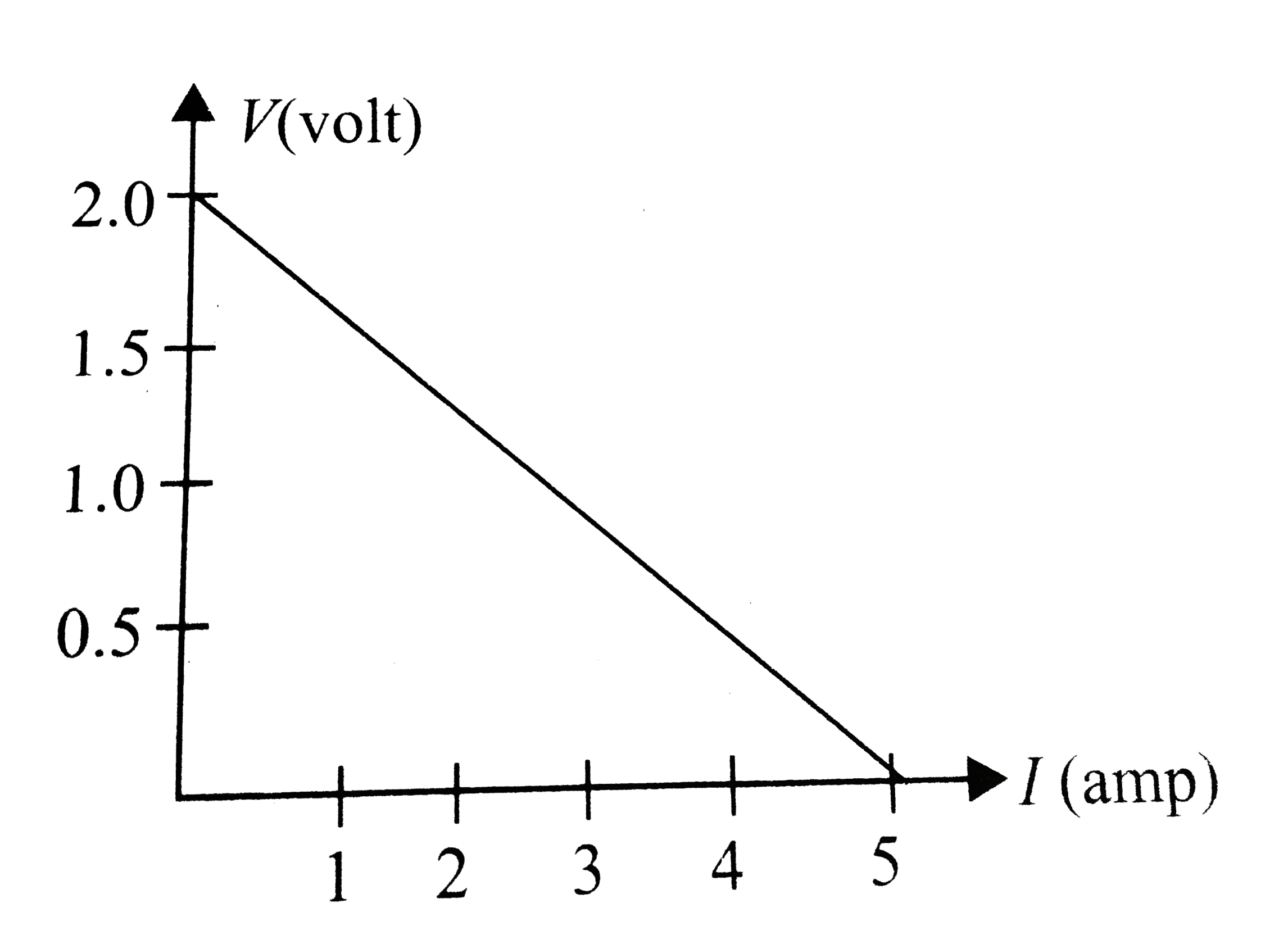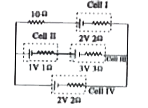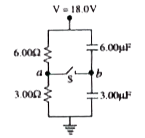PRACTICE SHEET (EXERCISE - VII LEVEL-II (ADVANCED) (Matrix Matching Type Questions)) from AAKASH SERIES CURRENT ELECTRICITY for Class 12
| Class 12 | PHYSICS |
| Chapter | CURRENT ELECTRICITY |
| AAKASH SERIES | PRACTICE SHEET (EXERCISE - VII LEVEL-II (ADVANCED) (Matrix Matching Type Questions)) |
| Medium | English |
| Academic Year | 2023-2024 |
Question 12
Passage-I :
Two large plates are located in vacuum. One of them serves as a cathode, a source of electrons whose initial velocity is negligible. An electron flow directed toward the opposite plate produces a space charge causing the potential in the gap between the plates to vary as V=ax4/3, where a is a positive constant, and x is the distance from the cathode.

The electric field between the plate as a function of x is View SolutionQuestion 14
Passage-I :
Two large plates are located in vacuum. One of them serves as a cathode, a source of electrons whose initial velocity is negligible. An electron flow directed toward the opposite plate produces a space charge causing the potential in the gap between the plates to vary as V=ax4/3, where a is a positive constant, and x is the distance from the cathode.

The current density View SolutionQuestion 15
Consider a block of conducting material of resistivity p shown in the figure. Current I enters at A and leaves from D. We apply superposition principle to find voltage Δv developed between B and C. The calculation is done in the following steps :

(i) Take current I entering from A and assume it to spread over a hemispherical surface in the block.
(ii) Calculate filed E(r) at distance r from A by using Ohm’s law E=π where j is the current per unit area at r.
(iii) From the r dependence of E(r), obtain the potential V(r) at r.
(iv) Repeat (i), (ii) and (iii) for current I leaving D and superpose result for A and D.
Δvmeasured between B and C is : View SolutionQuestion 16
Passage-II:
Consider a block conducting material of resistivity .ρ. shown in the figure. Current .I. enters at .A. and leaves from .D.. We apply superposition principle to find voltage .ΔV. developed between .B. and .C.. The calculation is done in the following steps :
i) Take current .I. entering from .A. and assume it to spread over a hemispherical surface in the block.
ii) Calculate field E(r ) at distance .r. from A by using Ohm.s law E=ρj, where j is the current per unit area at .r..
iii) From the .r. dependence of E(r ), obtain the potential V(r ) at r.
iv) Repeat (i), (ii), (iii) for current .I. leaving .D. and superpose results for .A. and .D..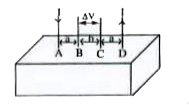
For current entering at A the electric field at a distance .r. from A is View SolutionQuestion 17
Column - I gives physical quantities of a situation in which a current I passes through two rods I and II of equal length that are joined in series. The ratio of free electron density (n), resistivity (ρ) and corss - section area (A) of both are in ratio n1:n2=2:1 and A1:A2=1:2 respectively. Column II gives corresponding results. Match the ratios in the column I with the values in column II
 View Solution
View SolutionQuestion 18
The area of cross-section, length and density of a piece of a metal of atomic weight 60 are 10−6m2, 1.0m and 5×103kg/m3 respectively, every atom contributes one free electron. (Given Avogadro number =6×1023/mol). Find the drift velocity of electrons in the metal when the current of 16A passes through:View SolutionQuestion 19
A straight copper-wire of length 1 = 1000 m and corss-sectional area A = 1.0 mm2 carries a current i=4.5A. The sum of electric forces acting on all free electrons in the given wire is M×106N. Find M. Free electron density and resistivity of copper are 8.5×1028/m3 and 1.7×10−8Ω.m respectively. View SolutionQuestion 25
You are given several identical resisters each of value 5Ω and each capable of carrying a maximum current of 2A. It is required to make a suitable combination of these resistance to produce a resistance of 2.5Ω which can carry current of 4A. The minimum number of resistances required for this job is View SolutionQuestion 34
This quesiton contains Statement-1 and Statement-2. Of the four choices given after the statement, choose the one that best describes the two statements.
Statement-1 : The temperature dependence of resistance is usually given as R=R0(1+αΔt). The resistance of a wire changes from 100Ω to 150Ω when its temperture is increased from 27∘C to 227∘C. This implies that α=2.5×10−3/.∘C.
Statement -2 : R=R1(1+αΔT) is valid only when the change in the temperature ΔT is small and δR=(R−R0)<<R0View SolutionQuestion 88
The length of potentiometer wire is 200 cm and the emf of standard cell is primary circuit is E volts. It is employed to a battery of emf 0.4 v the balance point is obtained at l = 40 cm from positive end, the E of the battery is (cell in primary is ideal and series resistance is zone View SolutionQuestion 100
In an experiment for calibration of voltmeter, a standard cell of emf 1.5V is balanced at 300cm length of potentiometer wire. The P.D across a resistance in the circuit is balancedat 1.25m. If a voltmeter is connected across the same resistance. It reads 0.65V. The errorin the volt meter is View SolutionQuestion 102
A galvanometer having a resistance of 50Ω , gives a full scale deflection for a current if 0.05 A. The length in metre if a resistance wire of area of cross- section 2.97×10−2cm2 that can be used to convert the gaivanometer into an ammeter which can read a maximum of 5 A current is (specific resistance of the wire =5×10−7Ω−m) View SolutionQuestion 104
Deflection of galvanometer in the circuit is 71 divisions. A shunt of 15Ω is connected parallel to galvanometer and value of R is adjusted such that main current ramains the same. If the deflection in the galvanometer falls to 15 divisions then the resistance G of galvanometer in (in ohm)
 View Solution
View SolutionQuestion 125
A conductor is made of an isotropic material and has shape of a truncated cone. A battery of constant emf is connected across it and its left end is earthed as shown. If at a certain section at a distance x form left end, electric field intensity and the rate of generation of heat per unit length are E and H respectively, which of the following graphs is (are) correct?
 View Solution
View SolutionQuestion 127
Passage :
A battery EA of 123 volts emf internal resistance 0.4Ω and a battery EB of 117 V emf and internal resistance 0.6Ω supplies a current to load resistance RL through four wires of resistors RA=1.2Ω,RB=1Ω,RC=1.4ΩandRD=1.4Ω as shown in figure.

The value of load resistance for maximum load power is View SolutionQuestion 128
Passage :
A battery EA of 123 volts emf internal resistance 0.4Ω and a battery EB of 117 V emf and internal resistance 0.6Ω supplies a current to load resistance RL through four wires of resistors RA=1.2Ω,RB=1Ω,RC=1.4ΩandRD=1.4Ω as shown in figure.

The value of load resistance for maximum load power is View SolutionQuestion 129
Passage :
A battery EA of 123 volts emf internal resistance 0.4Ω and a battery EB of 117 V emf and internal resistance 0.6Ω supplies a current to load resistance RL through four wires of resistors RA=1.2Ω,RB=1Ω,RC=1.4ΩandRD=1.4Ω as shown in figure.

The value of load resistance for maximum load power is View Solution
All Exercises from AAKASH SERIES Class 12 PHYSICS CURRENT ELECTRICITY
- EXERCISE - IA
- EXERCISE - IB
- LECTURE SHEET (EXERCISE- II LEVEL- II (ADVANCED) (LINKED COMPREHENSION TYPE QUESTIONS))
- LECTURE SHEET (EXERCISE- II LEVEL- II (ADVANCED) (MATRIX MATCHING TYPE QUESTIONS))
- LECTURE SHEET (EXERCISE- II LEVEL- II (ADVANCED) (STRAIGHT OBJECTIVE TYPE QUESTIONS))
- LECTURE SHEET (EXERCISE- II LEVEL-I (MAIN) (STRAIGHT OBJECTIVE TYPE QUESTIONS))
- LECTURE SHEET (EXERCISE-I LEVEL- II (ADVANCED) (MORE THAN ONE CORRECT ANSWER TYPE QUESTIONS))
- LECTURE SHEET (EXERCISE-I LEVEL- II (ADVANCED) (STRAIGHT OBJECTIVE TYPE QUESTIONS))
- LECTURE SHEET (EXERCISE-I LEVEL-1(MAIN) (STRAIGHT OBJECTIVE TYPE QUESTIONS))
- LECTURE SHEET (EXERCISE-III LEVEL- I (MAIN) (STRAIGHT OBJECTIVE TYPE QUESTIONS))
- LECTURE SHEET (EXERCISE-III LEVEL- II (ADVANCED) (LINKED COMPREHENSION TYPE QUESTIONS)
- LECTURE SHEET (EXERCISE-III LEVEL- II (ADVANCED) (MATRIX MATCHING TYPE QUESTIONS)
- LECTURE SHEET (EXERCISE-III LEVEL- II (ADVANCED) (STRAIGHT OBJECTIVE TYPE QUESTIONS))
- LECTURE SHEET (EXERCISE-IV LEVEL - I (MAIN) (STRAIGHT OBJECTIVE TYPE QUESTIONS))
- LECTURE SHEET (EXERCISE-IV LEVEL- II (ADVANCED) (INTEGER TYPE QUESTIONS))
- LECTURE SHEET (EXERCISE-IV LEVEL- II (ADVANCED) (LINKED COMPREHENSION TYPE QUESTIONS))
- LECTURE SHEET (EXERCISE-IV LEVEL- II (ADVANCED) (STRAIGHT OBJECTIVE TYPE QUESTIONS))
- LECTURE SHEET (EXERCISE-V LEVEL - I (MAIN) (STRAIGHT OBJECTIVE TYPE QUESTIONS))
- LECTURE SHEET (EXERCISE-V LEVEL-II (ADVANCED) (STRAIGHT OBJECTIVE TYPE QUESTIONS))
- LECTURE SHEET (EXERCISE-VI LEVEL - I (MAIN) (STRAIGHT OBJECTIVE TYPE QUESTIONS))
- LECTURE SHEET (EXERCISE-VI LEVEL- II (ADVANCED) (MATRIX MATCHING TYPE QUESTIONS))
- LECTURE SHEET (EXERCISE-VI LEVEL- II (ADVANCED) (STRAIGHT OBJECTIVE TYPE QUESTIONS))
- LECTURE SHEET (EXERCISE-VII LEVEL - I (MAIN) (STRAIGHT OBJECTIVE TYPE QUESTIONS))
- LECTURE SHEET (EXERCISE-VII LEVEL-II (ADVANCED) (LINKED COMPREHENSION TYPE QUESTIONS))
- LECTURE SHEET (EXERCISE-VII LEVEL-II (ADVANCED) (STRAIGHT OBJECTIVE TYPE QUESTIONS))
- EXERCISE - IA
- EXERCISE - IB
- LECTURE SHEET (EXERCISE- II LEVEL- II (ADVANCED) (LINKED COMPREHENSION TYPE QUESTIONS))
- LECTURE SHEET (EXERCISE- II LEVEL- II (ADVANCED) (MATRIX MATCHING TYPE QUESTIONS))
- LECTURE SHEET (EXERCISE- II LEVEL- II (ADVANCED) (STRAIGHT OBJECTIVE TYPE QUESTIONS))
- LECTURE SHEET (EXERCISE- II LEVEL-I (MAIN) (STRAIGHT OBJECTIVE TYPE QUESTIONS))
- LECTURE SHEET (EXERCISE-I LEVEL- II (ADVANCED) (MORE THAN ONE CORRECT ANSWER TYPE QUESTIONS))
- LECTURE SHEET (EXERCISE-I LEVEL- II (ADVANCED) (STRAIGHT OBJECTIVE TYPE QUESTIONS))
- LECTURE SHEET (EXERCISE-I LEVEL-1(MAIN) (STRAIGHT OBJECTIVE TYPE QUESTIONS))
- LECTURE SHEET (EXERCISE-III LEVEL- I (MAIN) (STRAIGHT OBJECTIVE TYPE QUESTIONS))
- LECTURE SHEET (EXERCISE-III LEVEL- II (ADVANCED) (LINKED COMPREHENSION TYPE QUESTIONS)
- LECTURE SHEET (EXERCISE-III LEVEL- II (ADVANCED) (MATRIX MATCHING TYPE QUESTIONS)
- LECTURE SHEET (EXERCISE-III LEVEL- II (ADVANCED) (STRAIGHT OBJECTIVE TYPE QUESTIONS))
- LECTURE SHEET (EXERCISE-IV LEVEL - I (MAIN) (STRAIGHT OBJECTIVE TYPE QUESTIONS))
- LECTURE SHEET (EXERCISE-IV LEVEL- II (ADVANCED) (INTEGER TYPE QUESTIONS))
- LECTURE SHEET (EXERCISE-IV LEVEL- II (ADVANCED) (LINKED COMPREHENSION TYPE QUESTIONS))
- LECTURE SHEET (EXERCISE-IV LEVEL- II (ADVANCED) (STRAIGHT OBJECTIVE TYPE QUESTIONS))
- LECTURE SHEET (EXERCISE-V LEVEL - I (MAIN) (STRAIGHT OBJECTIVE TYPE QUESTIONS))
- LECTURE SHEET (EXERCISE-V LEVEL-II (ADVANCED) (STRAIGHT OBJECTIVE TYPE QUESTIONS))
- LECTURE SHEET (EXERCISE-VI LEVEL - I (MAIN) (STRAIGHT OBJECTIVE TYPE QUESTIONS))
- LECTURE SHEET (EXERCISE-VI LEVEL- II (ADVANCED) (MATRIX MATCHING TYPE QUESTIONS))
- LECTURE SHEET (EXERCISE-VI LEVEL- II (ADVANCED) (STRAIGHT OBJECTIVE TYPE QUESTIONS))
- LECTURE SHEET (EXERCISE-VII LEVEL - I (MAIN) (STRAIGHT OBJECTIVE TYPE QUESTIONS))
- LECTURE SHEET (EXERCISE-VII LEVEL-II (ADVANCED) (LINKED COMPREHENSION TYPE QUESTIONS))
- LECTURE SHEET (EXERCISE-VII LEVEL-II (ADVANCED) (STRAIGHT OBJECTIVE TYPE QUESTIONS))
- EXERCISE - IA
- EXERCISE - IB
- LECTURE SHEET (EXERCISE- II LEVEL- II (ADVANCED) (LINKED COMPREHENSION TYPE QUESTIONS))
- LECTURE SHEET (EXERCISE- II LEVEL- II (ADVANCED) (MATRIX MATCHING TYPE QUESTIONS))
- LECTURE SHEET (EXERCISE- II LEVEL- II (ADVANCED) (STRAIGHT OBJECTIVE TYPE QUESTIONS))
- LECTURE SHEET (EXERCISE- II LEVEL-I (MAIN) (STRAIGHT OBJECTIVE TYPE QUESTIONS))
- LECTURE SHEET (EXERCISE-I LEVEL- II (ADVANCED) (MORE THAN ONE CORRECT ANSWER TYPE QUESTIONS))
- LECTURE SHEET (EXERCISE-I LEVEL- II (ADVANCED) (STRAIGHT OBJECTIVE TYPE QUESTIONS))
- LECTURE SHEET (EXERCISE-I LEVEL-1(MAIN) (STRAIGHT OBJECTIVE TYPE QUESTIONS))
- LECTURE SHEET (EXERCISE-III LEVEL- I (MAIN) (STRAIGHT OBJECTIVE TYPE QUESTIONS))
- LECTURE SHEET (EXERCISE-III LEVEL- II (ADVANCED) (LINKED COMPREHENSION TYPE QUESTIONS)
- LECTURE SHEET (EXERCISE-III LEVEL- II (ADVANCED) (MATRIX MATCHING TYPE QUESTIONS)
- LECTURE SHEET (EXERCISE-III LEVEL- II (ADVANCED) (STRAIGHT OBJECTIVE TYPE QUESTIONS))
- LECTURE SHEET (EXERCISE-IV LEVEL - I (MAIN) (STRAIGHT OBJECTIVE TYPE QUESTIONS))
- LECTURE SHEET (EXERCISE-IV LEVEL- II (ADVANCED) (INTEGER TYPE QUESTIONS))
- LECTURE SHEET (EXERCISE-IV LEVEL- II (ADVANCED) (LINKED COMPREHENSION TYPE QUESTIONS))
- LECTURE SHEET (EXERCISE-IV LEVEL- II (ADVANCED) (STRAIGHT OBJECTIVE TYPE QUESTIONS))
- LECTURE SHEET (EXERCISE-V LEVEL - I (MAIN) (STRAIGHT OBJECTIVE TYPE QUESTIONS))
- LECTURE SHEET (EXERCISE-V LEVEL-II (ADVANCED) (STRAIGHT OBJECTIVE TYPE QUESTIONS))
- LECTURE SHEET (EXERCISE-VI LEVEL - I (MAIN) (STRAIGHT OBJECTIVE TYPE QUESTIONS))
- LECTURE SHEET (EXERCISE-VI LEVEL- II (ADVANCED) (MATRIX MATCHING TYPE QUESTIONS))
- LECTURE SHEET (EXERCISE-VI LEVEL- II (ADVANCED) (STRAIGHT OBJECTIVE TYPE QUESTIONS))
- LECTURE SHEET (EXERCISE-VII LEVEL - I (MAIN) (STRAIGHT OBJECTIVE TYPE QUESTIONS))
- LECTURE SHEET (EXERCISE-VII LEVEL-II (ADVANCED) (LINKED COMPREHENSION TYPE QUESTIONS))
- LECTURE SHEET (EXERCISE-VII LEVEL-II (ADVANCED) (STRAIGHT OBJECTIVE TYPE QUESTIONS))
- EXERCISE - IA
- EXERCISE - IB
- LECTURE SHEET (EXERCISE- II LEVEL- II (ADVANCED) (LINKED COMPREHENSION TYPE QUESTIONS))
- LECTURE SHEET (EXERCISE- II LEVEL- II (ADVANCED) (MATRIX MATCHING TYPE QUESTIONS))
- LECTURE SHEET (EXERCISE- II LEVEL- II (ADVANCED) (STRAIGHT OBJECTIVE TYPE QUESTIONS))
- LECTURE SHEET (EXERCISE- II LEVEL-I (MAIN) (STRAIGHT OBJECTIVE TYPE QUESTIONS))
- LECTURE SHEET (EXERCISE-I LEVEL- II (ADVANCED) (MORE THAN ONE CORRECT ANSWER TYPE QUESTIONS))
- LECTURE SHEET (EXERCISE-I LEVEL- II (ADVANCED) (STRAIGHT OBJECTIVE TYPE QUESTIONS))
- LECTURE SHEET (EXERCISE-I LEVEL-1(MAIN) (STRAIGHT OBJECTIVE TYPE QUESTIONS))
- LECTURE SHEET (EXERCISE-III LEVEL- I (MAIN) (STRAIGHT OBJECTIVE TYPE QUESTIONS))
- LECTURE SHEET (EXERCISE-III LEVEL- II (ADVANCED) (LINKED COMPREHENSION TYPE QUESTIONS)
- LECTURE SHEET (EXERCISE-III LEVEL- II (ADVANCED) (MATRIX MATCHING TYPE QUESTIONS)
- LECTURE SHEET (EXERCISE-III LEVEL- II (ADVANCED) (STRAIGHT OBJECTIVE TYPE QUESTIONS))
- LECTURE SHEET (EXERCISE-IV LEVEL - I (MAIN) (STRAIGHT OBJECTIVE TYPE QUESTIONS))
- LECTURE SHEET (EXERCISE-IV LEVEL- II (ADVANCED) (INTEGER TYPE QUESTIONS))
- LECTURE SHEET (EXERCISE-IV LEVEL- II (ADVANCED) (LINKED COMPREHENSION TYPE QUESTIONS))
- LECTURE SHEET (EXERCISE-IV LEVEL- II (ADVANCED) (STRAIGHT OBJECTIVE TYPE QUESTIONS))
- LECTURE SHEET (EXERCISE-V LEVEL - I (MAIN) (STRAIGHT OBJECTIVE TYPE QUESTIONS))
- LECTURE SHEET (EXERCISE-V LEVEL-II (ADVANCED) (STRAIGHT OBJECTIVE TYPE QUESTIONS))
- LECTURE SHEET (EXERCISE-VI LEVEL - I (MAIN) (STRAIGHT OBJECTIVE TYPE QUESTIONS))
- LECTURE SHEET (EXERCISE-VI LEVEL- II (ADVANCED) (MATRIX MATCHING TYPE QUESTIONS))
- LECTURE SHEET (EXERCISE-VI LEVEL- II (ADVANCED) (STRAIGHT OBJECTIVE TYPE QUESTIONS))
- LECTURE SHEET (EXERCISE-VII LEVEL - I (MAIN) (STRAIGHT OBJECTIVE TYPE QUESTIONS))
- LECTURE SHEET (EXERCISE-VII LEVEL-II (ADVANCED) (LINKED COMPREHENSION TYPE QUESTIONS))
- LECTURE SHEET (EXERCISE-VII LEVEL-II (ADVANCED) (STRAIGHT OBJECTIVE TYPE QUESTIONS))
- EXERCISE - II
- PRACTICE SHEET (EXERCISE - I LEVEL-I (MAIN) (STRAIGHT OBJECTIVE TYPE QUESTIONS))
- PRACTICE SHEET (EXERCISE - I LEVEL-II (ADVANCED) (INTEGER TYPE QUESTIONS))
- PRACTICE SHEET (EXERCISE - I LEVEL-II (ADVANCED) (LINKED COMPREHENSION TYPE QUESTIONS))
- PRACTICE SHEET (EXERCISE - I LEVEL-II (ADVANCED) (MATRIX MATCHING TYPE QUESTIONS))
- PRACTICE SHEET (EXERCISE - I LEVEL-II (ADVANCED) (MORE THAN ONE CORRECT ANSWER TYPE QUESTIONS))
- PRACTICE SHEET (EXERCISE - I LEVEL-II (ADVANCED) (STRAIGHT OBJECTIVE TYPE QUESTIONS))
- PRACTICE SHEET (EXERCISE - II LEVEL-I (MAIN) (STRAIGHT OBJECTIVE TYPE QUESTIONS))
- PRACTICE SHEET (EXERCISE - II LEVEL-II (ADVANCED) (INTEGER TYPE QUESTIONS))
- PRACTICE SHEET (EXERCISE - II LEVEL-II (ADVANCED) (MATRIX MATCHING TYPE QUESTIONS))
- PRACTICE SHEET (EXERCISE - II LEVEL-II (ADVANCED) (MORE THAN ONE CORRECT ANSWER TYPE QUESTIONS))
- PRACTICE SHEET (EXERCISE - III LEVEL-I (MAIN) (STRAIGHT OBJECTIVE TYPE QUESTIONS))
- PRACTICE SHEET (EXERCISE - III LEVEL-II (ADVANCED) (INTEGER TYPE QUESTIONS))
- PRACTICE SHEET (EXERCISE - III LEVEL-II (ADVANCED) (LINKED COMPREHENSION TYPE QUESTIONS))
- PRACTICE SHEET (EXERCISE - III LEVEL-II (ADVANCED) (MATCHING TYPE QUESTIONS))
- PRACTICE SHEET (EXERCISE - III LEVEL-II (ADVANCED) (MORE THAN ONE CORRECT ANSWER TYPE QUESTIONS))
- PRACTICE SHEET (EXERCISE - IV LEVEL-I (MAIN) (STRAIGHT OBJECTIVE TYPE QUESTIONS))
- PRACTICE SHEET (EXERCISE - IV LEVEL-II (ADVANCED) (INTEGER TYPE QUESTIONS))
- PRACTICE SHEET (EXERCISE - IV LEVEL-II (ADVANCED) (LINKED COMPREHENSION TYPE QUESTIONS))
- PRACTICE SHEET (EXERCISE - IV LEVEL-II (ADVANCED) (MORE THAN ONE CORRECT ANSWER TYPE QUESTIONS))
- PRACTICE SHEET (EXERCISE - V LEVEL-I (MAIN) (STRAIGHT OBJECTIVE TYPE QUESTIONS))
- PRACTICE SHEET (EXERCISE - V LEVEL-II (ADVANCED) (INTEGER TYPE QUESTIONS))
- PRACTICE SHEET (EXERCISE - V LEVEL-II (ADVANCED) (MORE THAN ONE CORRECT ANSWER TYPE QUESTIONS))
- PRACTICE SHEET (EXERCISE - V LEVEL-II (ADVANCED) (STRAIGHT OBJECTIVE TYPE QUESTIONS))
- PRACTICE SHEET (EXERCISE - VI LEVEL-I (MAIN) (STRAIGHT OBJECTIVE TYPE QUESTIONS))
- PRACTICE SHEET (EXERCISE - VI LEVEL-II (ADVANCED) (LINKED COMPREHENSION TYPE QUESTIONS))
- PRACTICE SHEET (EXERCISE - VI LEVEL-II (ADVANCED) (MORE THAN ONE CORRECT TYPE QUESTIONS))
- PRACTICE SHEET (EXERCISE - VI LEVEL-II (ADVANCED) (STRAIGHT OBJECTIVE TYPE QUESTIONS))
- PRACTICE SHEET (EXERCISE - VII LEVEL-I (MAIN) (STRAIGHT OBJECTIVE TYPE QUESTIONS))
- PRACTICE SHEET (EXERCISE - VII LEVEL-II (ADVANCED) (INTEGER TYPE QUESTIONS))
- PRACTICE SHEET (EXERCISE - VII LEVEL-II (ADVANCED) (MATRIX MATCHING TYPE QUESTIONS))
- PRACTICE SHEET (EXERCISE - VII LEVEL-II (ADVANCED) (MORE THAN ONE CORRECT ANSWER TYPE QUESTIONS))
- PRACTICE SHEET (EXERCISE - VII LEVEL-II (ADVANCED) (STRAIGHT OBJECTIVE TYPE QUESTIONS))
- EXERCISE - II
- PRACTICE SHEET (EXERCISE - I LEVEL-I (MAIN) (STRAIGHT OBJECTIVE TYPE QUESTIONS))
- PRACTICE SHEET (EXERCISE - I LEVEL-II (ADVANCED) (INTEGER TYPE QUESTIONS))
- PRACTICE SHEET (EXERCISE - I LEVEL-II (ADVANCED) (LINKED COMPREHENSION TYPE QUESTIONS))
- PRACTICE SHEET (EXERCISE - I LEVEL-II (ADVANCED) (MATRIX MATCHING TYPE QUESTIONS))
- PRACTICE SHEET (EXERCISE - I LEVEL-II (ADVANCED) (MORE THAN ONE CORRECT ANSWER TYPE QUESTIONS))
- PRACTICE SHEET (EXERCISE - I LEVEL-II (ADVANCED) (STRAIGHT OBJECTIVE TYPE QUESTIONS))
- PRACTICE SHEET (EXERCISE - II LEVEL-I (MAIN) (STRAIGHT OBJECTIVE TYPE QUESTIONS))
- PRACTICE SHEET (EXERCISE - II LEVEL-II (ADVANCED) (INTEGER TYPE QUESTIONS))
- PRACTICE SHEET (EXERCISE - II LEVEL-II (ADVANCED) (MATRIX MATCHING TYPE QUESTIONS))
- PRACTICE SHEET (EXERCISE - II LEVEL-II (ADVANCED) (MORE THAN ONE CORRECT ANSWER TYPE QUESTIONS))
- PRACTICE SHEET (EXERCISE - III LEVEL-I (MAIN) (STRAIGHT OBJECTIVE TYPE QUESTIONS))
- PRACTICE SHEET (EXERCISE - III LEVEL-II (ADVANCED) (INTEGER TYPE QUESTIONS))
- PRACTICE SHEET (EXERCISE - III LEVEL-II (ADVANCED) (LINKED COMPREHENSION TYPE QUESTIONS))
- PRACTICE SHEET (EXERCISE - III LEVEL-II (ADVANCED) (MATCHING TYPE QUESTIONS))
- PRACTICE SHEET (EXERCISE - III LEVEL-II (ADVANCED) (MORE THAN ONE CORRECT ANSWER TYPE QUESTIONS))
- PRACTICE SHEET (EXERCISE - IV LEVEL-I (MAIN) (STRAIGHT OBJECTIVE TYPE QUESTIONS))
- PRACTICE SHEET (EXERCISE - IV LEVEL-II (ADVANCED) (INTEGER TYPE QUESTIONS))
- PRACTICE SHEET (EXERCISE - IV LEVEL-II (ADVANCED) (LINKED COMPREHENSION TYPE QUESTIONS))
- PRACTICE SHEET (EXERCISE - IV LEVEL-II (ADVANCED) (MORE THAN ONE CORRECT ANSWER TYPE QUESTIONS))
- PRACTICE SHEET (EXERCISE - V LEVEL-I (MAIN) (STRAIGHT OBJECTIVE TYPE QUESTIONS))
- PRACTICE SHEET (EXERCISE - V LEVEL-II (ADVANCED) (INTEGER TYPE QUESTIONS))
- PRACTICE SHEET (EXERCISE - V LEVEL-II (ADVANCED) (MORE THAN ONE CORRECT ANSWER TYPE QUESTIONS))
- PRACTICE SHEET (EXERCISE - V LEVEL-II (ADVANCED) (STRAIGHT OBJECTIVE TYPE QUESTIONS))
- PRACTICE SHEET (EXERCISE - VI LEVEL-I (MAIN) (STRAIGHT OBJECTIVE TYPE QUESTIONS))
- PRACTICE SHEET (EXERCISE - VI LEVEL-II (ADVANCED) (LINKED COMPREHENSION TYPE QUESTIONS))
- PRACTICE SHEET (EXERCISE - VI LEVEL-II (ADVANCED) (MORE THAN ONE CORRECT TYPE QUESTIONS))
- PRACTICE SHEET (EXERCISE - VI LEVEL-II (ADVANCED) (STRAIGHT OBJECTIVE TYPE QUESTIONS))
- PRACTICE SHEET (EXERCISE - VII LEVEL-I (MAIN) (STRAIGHT OBJECTIVE TYPE QUESTIONS))
- PRACTICE SHEET (EXERCISE - VII LEVEL-II (ADVANCED) (INTEGER TYPE QUESTIONS))
- PRACTICE SHEET (EXERCISE - VII LEVEL-II (ADVANCED) (MATRIX MATCHING TYPE QUESTIONS))
- PRACTICE SHEET (EXERCISE - VII LEVEL-II (ADVANCED) (MORE THAN ONE CORRECT ANSWER TYPE QUESTIONS))
- PRACTICE SHEET (EXERCISE - VII LEVEL-II (ADVANCED) (STRAIGHT OBJECTIVE TYPE QUESTIONS))
- EXERCISE - II
- PRACTICE SHEET (EXERCISE - I LEVEL-I (MAIN) (STRAIGHT OBJECTIVE TYPE QUESTIONS))
- PRACTICE SHEET (EXERCISE - I LEVEL-II (ADVANCED) (INTEGER TYPE QUESTIONS))
- PRACTICE SHEET (EXERCISE - I LEVEL-II (ADVANCED) (LINKED COMPREHENSION TYPE QUESTIONS))
- PRACTICE SHEET (EXERCISE - I LEVEL-II (ADVANCED) (MATRIX MATCHING TYPE QUESTIONS))
- PRACTICE SHEET (EXERCISE - I LEVEL-II (ADVANCED) (MORE THAN ONE CORRECT ANSWER TYPE QUESTIONS))
- PRACTICE SHEET (EXERCISE - I LEVEL-II (ADVANCED) (STRAIGHT OBJECTIVE TYPE QUESTIONS))
- PRACTICE SHEET (EXERCISE - II LEVEL-I (MAIN) (STRAIGHT OBJECTIVE TYPE QUESTIONS))
- PRACTICE SHEET (EXERCISE - II LEVEL-II (ADVANCED) (INTEGER TYPE QUESTIONS))
- PRACTICE SHEET (EXERCISE - II LEVEL-II (ADVANCED) (MATRIX MATCHING TYPE QUESTIONS))
- PRACTICE SHEET (EXERCISE - II LEVEL-II (ADVANCED) (MORE THAN ONE CORRECT ANSWER TYPE QUESTIONS))
- PRACTICE SHEET (EXERCISE - III LEVEL-I (MAIN) (STRAIGHT OBJECTIVE TYPE QUESTIONS))
- PRACTICE SHEET (EXERCISE - III LEVEL-II (ADVANCED) (INTEGER TYPE QUESTIONS))
- PRACTICE SHEET (EXERCISE - III LEVEL-II (ADVANCED) (LINKED COMPREHENSION TYPE QUESTIONS))
- PRACTICE SHEET (EXERCISE - III LEVEL-II (ADVANCED) (MATCHING TYPE QUESTIONS))
- PRACTICE SHEET (EXERCISE - III LEVEL-II (ADVANCED) (MORE THAN ONE CORRECT ANSWER TYPE QUESTIONS))
- PRACTICE SHEET (EXERCISE - IV LEVEL-I (MAIN) (STRAIGHT OBJECTIVE TYPE QUESTIONS))
- PRACTICE SHEET (EXERCISE - IV LEVEL-II (ADVANCED) (INTEGER TYPE QUESTIONS))
- PRACTICE SHEET (EXERCISE - IV LEVEL-II (ADVANCED) (LINKED COMPREHENSION TYPE QUESTIONS))
- PRACTICE SHEET (EXERCISE - IV LEVEL-II (ADVANCED) (MORE THAN ONE CORRECT ANSWER TYPE QUESTIONS))
- PRACTICE SHEET (EXERCISE - V LEVEL-I (MAIN) (STRAIGHT OBJECTIVE TYPE QUESTIONS))
- PRACTICE SHEET (EXERCISE - V LEVEL-II (ADVANCED) (INTEGER TYPE QUESTIONS))
- PRACTICE SHEET (EXERCISE - V LEVEL-II (ADVANCED) (MORE THAN ONE CORRECT ANSWER TYPE QUESTIONS))
- PRACTICE SHEET (EXERCISE - V LEVEL-II (ADVANCED) (STRAIGHT OBJECTIVE TYPE QUESTIONS))
- PRACTICE SHEET (EXERCISE - VI LEVEL-I (MAIN) (STRAIGHT OBJECTIVE TYPE QUESTIONS))
- PRACTICE SHEET (EXERCISE - VI LEVEL-II (ADVANCED) (LINKED COMPREHENSION TYPE QUESTIONS))
- PRACTICE SHEET (EXERCISE - VI LEVEL-II (ADVANCED) (MORE THAN ONE CORRECT TYPE QUESTIONS))
- PRACTICE SHEET (EXERCISE - VI LEVEL-II (ADVANCED) (STRAIGHT OBJECTIVE TYPE QUESTIONS))
- PRACTICE SHEET (EXERCISE - VII LEVEL-I (MAIN) (STRAIGHT OBJECTIVE TYPE QUESTIONS))
- PRACTICE SHEET (EXERCISE - VII LEVEL-II (ADVANCED) (INTEGER TYPE QUESTIONS))
- PRACTICE SHEET (EXERCISE - VII LEVEL-II (ADVANCED) (MATRIX MATCHING TYPE QUESTIONS))
- PRACTICE SHEET (EXERCISE - VII LEVEL-II (ADVANCED) (MORE THAN ONE CORRECT ANSWER TYPE QUESTIONS))
- PRACTICE SHEET (EXERCISE - VII LEVEL-II (ADVANCED) (STRAIGHT OBJECTIVE TYPE QUESTIONS))
- EXERCISE - II
- PRACTICE SHEET (EXERCISE - I LEVEL-I (MAIN) (STRAIGHT OBJECTIVE TYPE QUESTIONS))
- PRACTICE SHEET (EXERCISE - I LEVEL-II (ADVANCED) (INTEGER TYPE QUESTIONS))
- PRACTICE SHEET (EXERCISE - I LEVEL-II (ADVANCED) (LINKED COMPREHENSION TYPE QUESTIONS))
- PRACTICE SHEET (EXERCISE - I LEVEL-II (ADVANCED) (MATRIX MATCHING TYPE QUESTIONS))
- PRACTICE SHEET (EXERCISE - I LEVEL-II (ADVANCED) (MORE THAN ONE CORRECT ANSWER TYPE QUESTIONS))
- PRACTICE SHEET (EXERCISE - I LEVEL-II (ADVANCED) (STRAIGHT OBJECTIVE TYPE QUESTIONS))
- PRACTICE SHEET (EXERCISE - II LEVEL-I (MAIN) (STRAIGHT OBJECTIVE TYPE QUESTIONS))
- PRACTICE SHEET (EXERCISE - II LEVEL-II (ADVANCED) (INTEGER TYPE QUESTIONS))
- PRACTICE SHEET (EXERCISE - II LEVEL-II (ADVANCED) (MATRIX MATCHING TYPE QUESTIONS))
- PRACTICE SHEET (EXERCISE - II LEVEL-II (ADVANCED) (MORE THAN ONE CORRECT ANSWER TYPE QUESTIONS))
- PRACTICE SHEET (EXERCISE - III LEVEL-I (MAIN) (STRAIGHT OBJECTIVE TYPE QUESTIONS))
- PRACTICE SHEET (EXERCISE - III LEVEL-II (ADVANCED) (INTEGER TYPE QUESTIONS))
- PRACTICE SHEET (EXERCISE - III LEVEL-II (ADVANCED) (LINKED COMPREHENSION TYPE QUESTIONS))
- PRACTICE SHEET (EXERCISE - III LEVEL-II (ADVANCED) (MATCHING TYPE QUESTIONS))
- PRACTICE SHEET (EXERCISE - III LEVEL-II (ADVANCED) (MORE THAN ONE CORRECT ANSWER TYPE QUESTIONS))
- PRACTICE SHEET (EXERCISE - IV LEVEL-I (MAIN) (STRAIGHT OBJECTIVE TYPE QUESTIONS))
- PRACTICE SHEET (EXERCISE - IV LEVEL-II (ADVANCED) (INTEGER TYPE QUESTIONS))
- PRACTICE SHEET (EXERCISE - IV LEVEL-II (ADVANCED) (LINKED COMPREHENSION TYPE QUESTIONS))
- PRACTICE SHEET (EXERCISE - IV LEVEL-II (ADVANCED) (MORE THAN ONE CORRECT ANSWER TYPE QUESTIONS))
- PRACTICE SHEET (EXERCISE - V LEVEL-I (MAIN) (STRAIGHT OBJECTIVE TYPE QUESTIONS))
- PRACTICE SHEET (EXERCISE - V LEVEL-II (ADVANCED) (INTEGER TYPE QUESTIONS))
- PRACTICE SHEET (EXERCISE - V LEVEL-II (ADVANCED) (MORE THAN ONE CORRECT ANSWER TYPE QUESTIONS))
- PRACTICE SHEET (EXERCISE - V LEVEL-II (ADVANCED) (STRAIGHT OBJECTIVE TYPE QUESTIONS))
- PRACTICE SHEET (EXERCISE - VI LEVEL-I (MAIN) (STRAIGHT OBJECTIVE TYPE QUESTIONS))
- PRACTICE SHEET (EXERCISE - VI LEVEL-II (ADVANCED) (LINKED COMPREHENSION TYPE QUESTIONS))
- PRACTICE SHEET (EXERCISE - VI LEVEL-II (ADVANCED) (MORE THAN ONE CORRECT TYPE QUESTIONS))
- PRACTICE SHEET (EXERCISE - VI LEVEL-II (ADVANCED) (STRAIGHT OBJECTIVE TYPE QUESTIONS))
- PRACTICE SHEET (EXERCISE - VII LEVEL-I (MAIN) (STRAIGHT OBJECTIVE TYPE QUESTIONS))
- PRACTICE SHEET (EXERCISE - VII LEVEL-II (ADVANCED) (INTEGER TYPE QUESTIONS))
- PRACTICE SHEET (EXERCISE - VII LEVEL-II (ADVANCED) (MATRIX MATCHING TYPE QUESTIONS))
- PRACTICE SHEET (EXERCISE - VII LEVEL-II (ADVANCED) (MORE THAN ONE CORRECT ANSWER TYPE QUESTIONS))
- PRACTICE SHEET (EXERCISE - VII LEVEL-II (ADVANCED) (STRAIGHT OBJECTIVE TYPE QUESTIONS))
- ADDITIONAL PRACTICE EXERCISE (LEVEL -I(MAIN) (STRAIGHT OBJECTIVE TYPE QUESTIONS))
- ADDITIONAL PRACTICE EXERCISE (LEVEL -II LECTURE SHEET (ADVANCED) (INTEGER TYPE QUESTIONS))
- ADDITIONAL PRACTICE EXERCISE (LEVEL -II LECTURE SHEET (ADVANCED) (MATRIX MATCHING TYPE QUESTIONS))
- ADDITIONAL PRACTICE EXERCISE (LEVEL -II LECTURE SHEET (ADVANCED) (STRAIGHT OBJECTIVE TYPE QUESTIONS))
- ADDITIONAL PRACTICE EXERCISE (LEVEL -II PRACTICE SHEET (ADVANCED) (LINKED COMPREHENSION TYPE QUESTIONS))
- ADDITIONAL PRACTICE EXERCISE (LEVEL -II PRACTICE SHEET (ADVANCED) (MORE THAN ONE CORRECT ANSWER TYPE QUESTIONS))
- ADDITIONAL PRACTICE EXERCISE (LEVEL -II PRACTICE SHEET (ADVANCED) (STRAIGHT OBJECTIVE TYPE QUESTIONS))
- EXERCISE - III
- ADDITIONAL PRACTICE EXERCISE (LEVEL -I(MAIN) (STRAIGHT OBJECTIVE TYPE QUESTIONS))
- ADDITIONAL PRACTICE EXERCISE (LEVEL -II LECTURE SHEET (ADVANCED) (INTEGER TYPE QUESTIONS))
- ADDITIONAL PRACTICE EXERCISE (LEVEL -II LECTURE SHEET (ADVANCED) (MATRIX MATCHING TYPE QUESTIONS))
- ADDITIONAL PRACTICE EXERCISE (LEVEL -II LECTURE SHEET (ADVANCED) (STRAIGHT OBJECTIVE TYPE QUESTIONS))
- ADDITIONAL PRACTICE EXERCISE (LEVEL -II PRACTICE SHEET (ADVANCED) (LINKED COMPREHENSION TYPE QUESTIONS))
- ADDITIONAL PRACTICE EXERCISE (LEVEL -II PRACTICE SHEET (ADVANCED) (MORE THAN ONE CORRECT ANSWER TYPE QUESTIONS))
- ADDITIONAL PRACTICE EXERCISE (LEVEL -II PRACTICE SHEET (ADVANCED) (STRAIGHT OBJECTIVE TYPE QUESTIONS))
- EXERCISE - III
- ADDITIONAL PRACTICE EXERCISE (LEVEL -I(MAIN) (STRAIGHT OBJECTIVE TYPE QUESTIONS))
- ADDITIONAL PRACTICE EXERCISE (LEVEL -II LECTURE SHEET (ADVANCED) (INTEGER TYPE QUESTIONS))
- ADDITIONAL PRACTICE EXERCISE (LEVEL -II LECTURE SHEET (ADVANCED) (MATRIX MATCHING TYPE QUESTIONS))
- ADDITIONAL PRACTICE EXERCISE (LEVEL -II LECTURE SHEET (ADVANCED) (STRAIGHT OBJECTIVE TYPE QUESTIONS))
- ADDITIONAL PRACTICE EXERCISE (LEVEL -II PRACTICE SHEET (ADVANCED) (LINKED COMPREHENSION TYPE QUESTIONS))
- ADDITIONAL PRACTICE EXERCISE (LEVEL -II PRACTICE SHEET (ADVANCED) (MORE THAN ONE CORRECT ANSWER TYPE QUESTIONS))
- ADDITIONAL PRACTICE EXERCISE (LEVEL -II PRACTICE SHEET (ADVANCED) (STRAIGHT OBJECTIVE TYPE QUESTIONS))
- EXERCISE - III
- ADDITIONAL PRACTICE EXERCISE (LEVEL -I(MAIN) (STRAIGHT OBJECTIVE TYPE QUESTIONS))
- ADDITIONAL PRACTICE EXERCISE (LEVEL -II LECTURE SHEET (ADVANCED) (INTEGER TYPE QUESTIONS))
- ADDITIONAL PRACTICE EXERCISE (LEVEL -II LECTURE SHEET (ADVANCED) (MATRIX MATCHING TYPE QUESTIONS))
- ADDITIONAL PRACTICE EXERCISE (LEVEL -II LECTURE SHEET (ADVANCED) (STRAIGHT OBJECTIVE TYPE QUESTIONS))
- ADDITIONAL PRACTICE EXERCISE (LEVEL -II PRACTICE SHEET (ADVANCED) (LINKED COMPREHENSION TYPE QUESTIONS))
- ADDITIONAL PRACTICE EXERCISE (LEVEL -II PRACTICE SHEET (ADVANCED) (MORE THAN ONE CORRECT ANSWER TYPE QUESTIONS))
- ADDITIONAL PRACTICE EXERCISE (LEVEL -II PRACTICE SHEET (ADVANCED) (STRAIGHT OBJECTIVE TYPE QUESTIONS))
- EXERCISE - III
- PROBLEMS
- PROBLEMS
- PROBLEMS
- PROBLEMS






